IBHOF Blog: Leonard, Izenberg moved by the love in Canastota

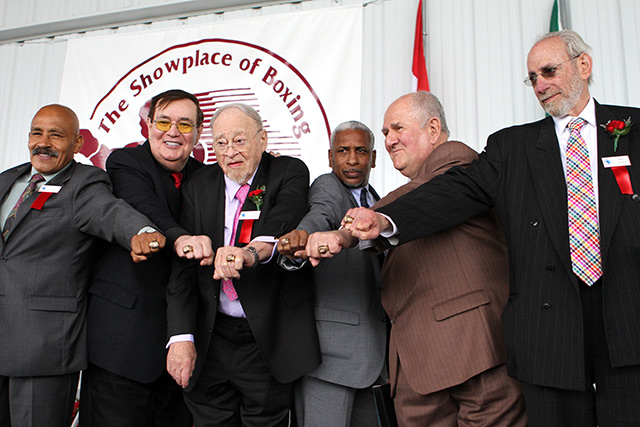
From left to right: Lupe Pintor, Col. Bob Sheridan, Jerry Izenberg, Hilario Zapata, Harold Lederman and Marc Ratner pose at the induction ceremony for the International Boxing Hall of Fame. Photo: Mike Greenhill
CANASTOTA, N.Y. – Several years ago, Philadelphia billed itself as “the place that loves you back,” as an inducement to out-of-town visitors to come and sample all that the city has to offer.
There is no similar slogan touting the charms of this otherwise sleepy central New York village of 4,000 or so fulltime residents whose main appeal to tourists is the International Boxing Hall of Fame, which opened in 1989 and which welcomed its first class of inductees in 1990. But, in the second weekend of June for these past 27 years, that’s been more than enough to attract thousands of fight-loving pilgrims from around the world. “Boxing’s hometown,” Canastota calls itself, and “Title Town USA,” which might seem a bit portentous and self-important if weren’t for the fact that it basically is the truth.
Two legendary figures – five-division world champion Sugar Ray Leonard and esteemed journalist Jerry Izenberg – on Sunday joined the burgeoning ranks of those who have fallen under the spell of a town which gave the world one of boxing’s legendary figures, former welterweight and middleweight champ Carmen Basilio, taking the idea of honoring its favorite son with a statue and expanding it into a museum that has become a shrine to the sport as a whole.
Leonard, who was inducted into the IBHOF in 1997, has been here in the past, but this latest trip – as a member of the celebrated 1976 U.S. Olympic boxing team which won seven medals, including five golds – has convinced him that more regular appearances are not only warranted, but at the top of his personal to-do list.
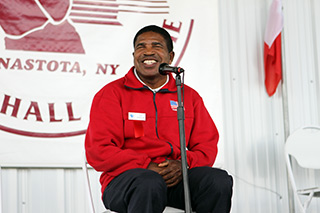
’76 Olympic gold medalist Leo Randolph. Photo: Greenhill
“I’ve been fighting for more than 50 years, and I’ve accomplished quite a bit,” said Leonard, 60, one of six members of the 1976 team who assembled for a 40-year reunion. “I’m a blessed man. But the greatest achievement I personally feel is being part of the1976 Olympic team in Montreal. I had an opportunity to be among some of the greatest fighters and teammates in the world.
“This is so special to me, coming here. I want to come here every year because there’s nothing like it. The love, the support ÔǪ if I can, I’ll be here every single year.”
Izenberg, 85, the award-winning sports columnist emeritus for the Newark Star-Ledger who previously had been inducted into 15 halls of fame, had never been here before. But, like so many others – where else can you see Leonard, Marvelous Marvin Hagler and Roberto Duran all sitting on the same stage, within an arm’s length of one another – he vows not to be a stranger in the future.
“Life has been very good to me,” said Izenberg, who was inducted in the Observer category. “I’ve covered athletic events in Europe, in Asia, in Africa and of course in the Western Hemisphere. But I’ve never been anywhere like Canastota, New York. I am amazed at the way this town has accepted all of us. I have never, ever experienced the kind of welcome and the kind of love that I feel here.”
It makes for the kind of warm, fuzzy feeling that can cause honorees and visitors almost forget the kind of torrential downpour that dampened some of Saturday’s festivities, or the low-50s temperatures and gusting winds on Sunday that made it seem more like late fall than early summer.
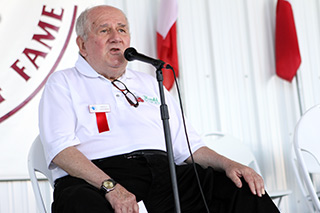
Harold Lederman. Photo: Greenhill
“It’s cold out here,” said Harold Lederman, 76, the unofficial judge for HBO’s boxing telecasts who was inducted in the Non-Participant category. “The parade was really cold. I saw a lady selling sweatshirts, hot chocolate and blankets.”
Although there have been bigger, and more temperate, turnouts for induction weekend (a bit of a misnomer since it stretches from Thursday through Sunday), this particular homage to all things boxing took on a special meaning in light of the passing of three-time heavyweight champion Muhammad Ali on June 3. The specter of “The Greatest” permeated the proceedings, proof that in death, as in life, Ali is the biggest thing going.
Col. Bob Sheridan, another inductee into the Observer category, recalled his introduction to Ali and to his future career.
“The very first prizefight I ever saw was as a sophomore at the University of Miami,” said Sheridan, who has been a boxing broadcaster for 50 years. “We went to the Miami Beach Convention Center to sell Coca-Cola for a fight between Cassius Clay and Sonny Liston. I sat down with my little Coke stand, looked up and said, ‘Man, this is professional boxing. How do you get into this?’
“It was unbelievable, and that was the influence Muhammad had (on Sheridan) that night. Two years later, after graduating, I started calling fights for Chris Dundee on radio. I did that for 13 years. If you were close to the Dundee brothers (Angelo was Chris’ younger brother), you were close to Muhammad Ali and I ended up calling about 20 of Ali’s fights.
“To think that I’ll be going into the Hall of Fame just a couple of days after ‘The Greatest’ was laid to rest is just very humbling to me. I love Muhammad as all of us did.”
Izenberg counted Ali as a friend for 50 years and he said the side of him that the public most often saw, the preening egotist who could back up his bold talk, masked a more private individual whose many good works went unpublicized because that’s the way he wanted it.
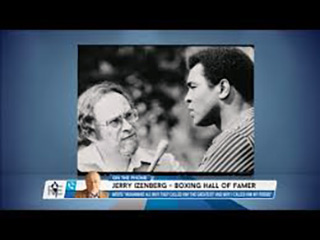 “I realize I am in the right place and why this is like a second home to me,” Izenberg said of the timing of his induction in such close proximity to the death of Ali. “He was perhaps one of the greatest, if not the greatest, humanitarians. To be here is a gift to me. It’s a marvelous, marvelous gift. Thank you, thank you, thank you. I will never forget this moment. And I will never forget any of you. As long as I can walk and as long as I can talk – I suspect the talking will last a lot longer – I’ll be here. I’ll be back.”
“I realize I am in the right place and why this is like a second home to me,” Izenberg said of the timing of his induction in such close proximity to the death of Ali. “He was perhaps one of the greatest, if not the greatest, humanitarians. To be here is a gift to me. It’s a marvelous, marvelous gift. Thank you, thank you, thank you. I will never forget this moment. And I will never forget any of you. As long as I can walk and as long as I can talk – I suspect the talking will last a lot longer – I’ll be here. I’ll be back.”
Other inductees in the IBHOF’s Class of 2016 include Mexico’s Lupe Pintor, Panama’s Hilario Zapata and, posthumously, Hector “Macho” Camacho, in the Modern category, and Marc Ratner, former executive director of the Nevada State Athletic Commission, in the Non-Participant. In addition to Camacho, posthumous inductees include longtime New Orleans-based trainer Whitey Esneault (Non-Participant) and Petey Sarron (Old-Timer).
Camacho, a former three-division world champion who was 50 when he was shot and killed by an unknown assailant in his native Puerto Rico in 2012, was a slick-boxing, flamboyant southpaw who posted a 79-6-3 record with 38 knockout victories who made it to the final bell in all 88 of his pro bouts.
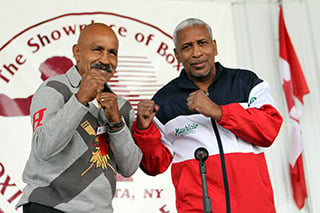
Lupe Pintor (L) and Hilario Zapata (R). Photo: Greenhill
Pintor, 61, won world titles as a bantamweight and super bantamweight who posted a 56-14-2 (42 KOs) record, while Zapata, 57, was an agile southpaw who reigned as a flyweight and super flyweight en route to a final career mark of 43-10-1 (15).
Ratner, 71, is best known for his astute handling of two of boxing’s most controversial fights – the “Fan Man” fight that temporarily disrupted the second matchup of Riddick Bowe and Evander Holyfield, and the “Bite Fight” in which Mike Tyson was disqualified after twice biting Holyfield’s right ear.
“There’s nothing in the rule book that says what to do when a guy flies into the ring,” Ratner said of the “Fan Man” incident, which took place at the outdoor arena at Las Vegas’ Caesars Palace.
















